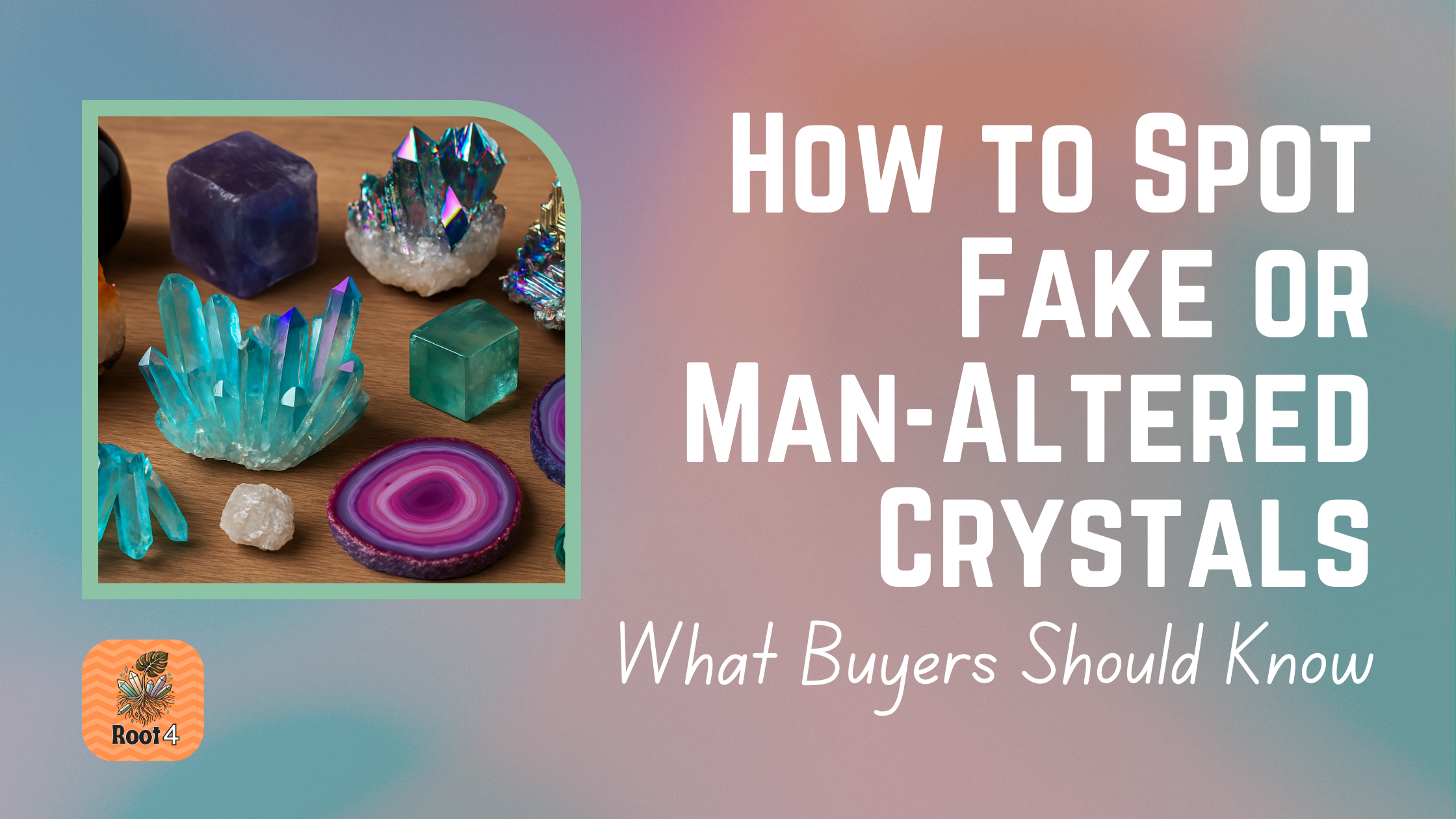Your cart is currently empty!

How to Spot Fake or Man-Altered Crystals: What Buyers Should Know
The crystal and mineral world is full of stunning specimens, each with their own natural formation story. But not every crystal you see on the shelf (or online) got its color, shine, or shape straight from the Earth. Many pieces on the market are altered by humans to enhance their appearance—or mimic more valuable stones. Some are still technically “natural,” while others are synthetic or outright fakes.
Here’s how to identify common man-altered crystals, spot the signs of fakes, and make more informed choices when adding to your collection.
🔥 1. Heat-Treated Amethyst Sold as Citrine
One of the most common examples of human-altered crystals is heat-treated amethyst. When amethyst is heated to high temperatures (usually in a lab), it changes color to a yellow-orange hue resembling citrine. These are often marketed as “citrine” but are technically altered amethyst.
🔎 What to look for:
- A bright, burnt-orange or amber tone (vs. the pale golden yellow of natural citrine)
- White bases or uneven color zoning
- Clusters that look like amethyst but are orange instead of purple
🧪 Is it fake?
No, it’s still quartz—but it’s not naturally occurring citrine. Some sellers disclose this, but many don’t.
☢️ 2. Irradiated Fluorite
Fluorite naturally comes in a wide range of colors, but some vivid neon greens and blues are artificially achieved through irradiation—a process where the stone is exposed to radiation to alter its color.
🔎 What to look for:
- Unnaturally vibrant electric blue or radioactive-looking green
- A glassy, overly uniform surface with no visible zoning or banding
🧪 Is it fake?
Not necessarily—it’s real fluorite, just altered. These pieces can eventually fade in sunlight, so even their beauty may not be permanent.
🌈 3. Aura Quartz (Electroplated Crystals)
Aura quartz is created by bonding natural quartz with metal vapor (like titanium or gold) to give it a rainbow or iridescent coating.
🔎 What to look for:
- An iridescent, metallic sheen not found in natural quartz
- A surface that may flake or wear over time
- An unnatural color shift depending on lighting
🧪 Is it fake?
The quartz is real, but the color is a man-made effect.
🎨 4. Dyed Agate & Quartz Geodes
Some agate slices and geodes are dyed vibrant colors like hot pink, bright teal, or neon purple to make them more eye-catching.
🔎 What to look for:
- Overly bright, saturated, synthetic-looking colors
- Dyes that rub off slightly on fingers or paper towels when wet
- Uniform color that seeps into cracks or matrix
🧪 Is it fake?
The base material is real agate or quartz, but the color is added artificially.
🔍 5. Glass “Crystals” or Resin Imitations
Some sparkly or colorful “crystals” are actually glass or resin, molded and colored to resemble natural minerals like amethyst, quartz points, or even moldavite.
🔎 What to look for:
- Perfect symmetry or air bubbles inside
- A plastic or overly smooth feel
- Very low cost for something labeled as rare or high-vibration
🧪 Is it fake?
Yes—these are synthetic imitations, not true minerals.
🧩 6. Reconstructed or Reconstituted Stones
Some stones, like turquoise, malachite, or lapis lazuli, are crushed into powder, mixed with resin or dyes, and then molded into shapes.
🔎 What to look for:
- Uniform patterns that don’t match natural veining
- A plastic-like surface sheen
- “Perfect” cabochons that seem too uniform
🧪 Is it fake?
It’s man-made. It may contain some real mineral, but it’s no longer in its natural form.
✨ 7. Labradorite or Moonstone Lookalikes
Some glass items are sold as moonstone or labradorite because they have a shimmer, but they lack the structure or depth of genuine feldspar.
🔎 What to look for:
- Surface sparkle instead of depth or chatoyancy
- No color play at certain angles
- Lack of any matrix or earthy inclusions
🧪 Is it fake?
Yes—these are glass imitations, not true feldspar minerals.
⚫ 8. Obsidian Mislabeling
Some sellers market black glass or dyed glass as obsidian, but true volcanic obsidian has a specific natural texture and weight.
🔎 What to look for:
- Lightweight pieces for their size
- A smooth, plasticky feel
- Bubbles inside the material
🧪 Is it fake?
Yes, if it’s glass being passed off as natural volcanic obsidian.
💚 9. Moldavite, Tektite & Quartz Fakes
Moldavite has become one of the most faked crystals on the market. Tektites and even quartz points are also frequently faked using glass or plastic.
🔎 What to look for:
- Moldavite: overly smooth texture, trapped bubbles, green bottle-glass color
- Tektites: lack of pitted or natural “meteor impact” surface
- Quartz: visible mold seams, air bubbles
🧪 Is it fake?
Yes—true tektites and moldavite have irregular, matte textures. Glass fakes are shiny and often symmetrical.
💫 10. Synthetic Bismuth
These vibrant, rainbow stair-step crystals are always manmade. Bismuth occurs naturally but doesn’t form that way on its own.
🔎 What to look for:
- Geometric rainbow structures
- Extremely vibrant sheen
- No natural matrix or host rock
💡 Is it fake?
Not fake—but always lab-created.
🔷 11. Synthetic Quartz and Lab-Grown Crystals
Lab-grown quartz and other minerals are chemically identical to their natural counterparts but are formed in controlled environments.
🔎 What to look for:
- Ultra-clear or flawless crystals
- Identical terminations or repeating shapes
- No matrix or host rock
🧪 Is it fake?
Not fake, but not natural. Should be labeled as hydrothermal quartz, lab-grown, or synthetic—but often isn’t.
🌈 12. Copper-Treated “Peacock Ore” (Chalcopyrite)
Natural chalcopyrite can have a subtle rainbow effect, but most “peacock ore” is treated with acid or heat to enhance its colors.
🔎 What to look for:
- Neon, almost oily rainbow tones
- Color that chips or scratches off easily
🧪 Is it fake?
The base mineral is real, but the color is enhanced artificially.
🔮 13. Other Commonly Misrepresented Crystals
Here are a few more altered or fake specimens you may encounter:
- Blue “moonstone” – Often rainbow-lustered glass
- Fake malachite – Typically resin or polymer clay with printed banding
- Dyed citrine cathedrals – Often heat-treated amethyst or dyed quartz
- Opalite – A manmade glass often sold as opal or moonstone
- Resin “crystals” – Decorative pieces with glitter or faux inclusions
- Repaired specimens – Broken tips or geodes glued back together with filler
✅ How to Shop Smarter: Questions to Ask Before Buying
Whether you’re a new collector or a seasoned crystal lover, navigating the world of altered and synthetic specimens can be tricky. Not every altered stone is “bad”—but transparency is key. Asking the right questions helps ensure you’re getting exactly what you think you are.
Here are a few smart questions to ask sellers:
- Is this crystal natural, treated, or lab-grown?
- Has this piece been dyed, heat-treated, or irradiated?
- Where was this crystal sourced?
- Are you able to guarantee the authenticity of this piece?
- Is this the actual piece I’ll receive, or just a stock photo?
Asking these questions doesn’t make you difficult—it makes you intentional. The more aware you are, the more meaningful your collection becomes.
💎 Root 4’s Approach to Ethical Sourcing
At Root 4, we believe your connection to a crystal should start with honesty.
That’s why we clearly label whether a piece is raw, polished, treated, or lab-grown—so you can choose with intention, not assumption. While some altered stones can still be beautiful and meaningful, we don’t believe in selling anything under false pretenses.
Whenever possible, we source directly from trusted partners and small-scale suppliers who prioritize ethical practices and transparent origins. And if we ever carry treated or enhanced stones, you’ll know. No guessing, no greenwashed claims—just clarity.
Your space, energy, and values deserve pieces that feel good all the way through.
Final Thoughts: Is Altered Always Bad?
Not necessarily. Some collectors enjoy aura quartz or dyed stones for their aesthetics and creativity. But transparency matters—and knowing what you’re buying helps you build a collection that aligns with your values, whether you’re focused on metaphysical properties or geological authenticity.
At Root 4, we believe in celebrating both natural beauty and informed choices. Whenever possible, we offer clear details about whether a piece is raw, polished, altered, or synthetic—so you’re never left guessing.

Leave a Reply